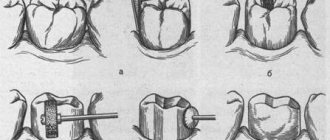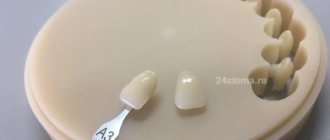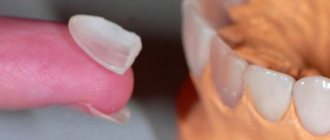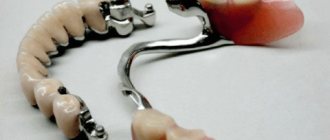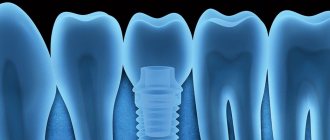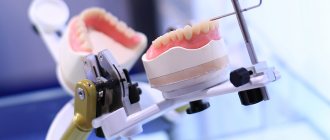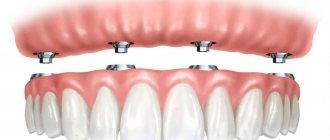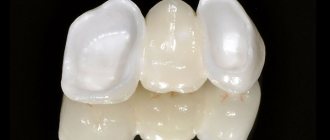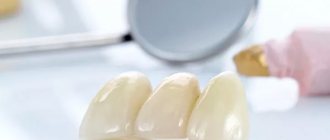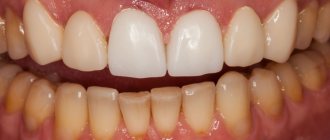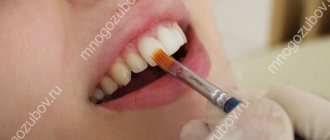From this article you will learn:
- pros and cons of ceramic zirconium crowns,
- their varieties - “Multi-layer”, monolithic, etc.,
- how much does a zirconium crown cost for 2021.
Zirconium crowns are a variant of dental crowns for restoring damaged and missing teeth, the material of which is zirconium dioxide (ZrO2). This material belongs to metal-free ceramics. Unlike metal-ceramics, zirconium dioxide crowns do not have a metal frame inside, which makes it possible to achieve a higher level of aesthetics in dental prosthetics (compared to metal-ceramic crowns).
Zirconium crowns also have very high strength. They are considered to be at least 2-4 times stronger than crowns made from other types of metal-free ceramics (for example, porcelain crowns). But all this is true only for crowns that are made of monolithic zirconium dioxide. In most cases, only the internal frame is milled from zirconium dioxide, on top of which layers of porcelain mass are applied. This allows you to achieve a higher level of aesthetics, but on the other hand, it increases the risk of chipping.
Zirconium crowns: photo
However, in recent years, a new technology for manufacturing zirconium crowns has emerged, which is called “Multi-layer”. This technology makes it possible to produce crowns from monolithic zirconia (i.e., without applying a surface layer of porcelain), and at the same time obtain esthetics almost comparable to the most esthetic types of metal-free ceramics, for example, crowns made of feldspathic porcelain or IPS E-max ceramics.
All this became possible thanks to the emergence of modern versions of zirconium dioxide blocks (disks), which are made using the “multi-layer” technology and also have high transparency (translucency characteristic of natural tooth enamel). In this article we will talk not only about the pros, but also about the disadvantages of ceramic crowns made of zirconium dioxide, and also why reviews of zirconium dental crowns from real patients are very often negative. And you probably already realized that this happens when dental clinics save money on better-quality consumables.
Zirconium crowns – in what cases can they be placed on implants, characteristics, prices
Article navigation
- Zirconium crowns - what are they?
- Classification
- Popular and quality brands
- Indications for use
- What are the contraindications?
- Manufacturing stages
- How is the implant installed?
- Advantages
- Disadvantages of zirconium crowns
- Prosthesis service life
- Rules for caring for dentures
- Patient reviews
- Price
question to a specialist
Dental crowns made of zirconium dioxide today are the best option for prosthetics.
Because they are distinguished by reliability, durability and excellent external characteristics. Zirconium prostheses successfully combine “metallic” strength and natural appearance. Further in the article we will talk about the features of zirconium dioxide crowns on implants - advantages and disadvantages, indications, installation methods and care rules.
Zirconium crowns – what are they?
Gradually, the usual metal-ceramic dental crowns are being replaced by a new generation of materials - in particular, zirconium dioxide (it contains only zirconium and oxygen). This is metal-free ceramics - however, not the usual fragile and snow-white porcelain, but a material that is incredibly durable. This is facilitated by the presence of the parent metal zirconium. Although the dioxide of this metal is white in color and does NOT possess important original “metallic” characteristics - luster, malleability and ductility, high thermal and electrical conductivity. That is, it is dioxide that is no longer a metal, and therefore it has no properties.
It is interesting that in ordinary ceramics (for dentures and other things) there are also metals that are part of the material. These are aluminum and potassium. And the very term “metal-free ceramics” in relation to zirconium dioxide means a method of making a crown - when the zirconium dioxide base is covered with ceramic mass on top for better aesthetics, but, as is clear from the term, there is no metal in the composition. Although we repeat that dioxide is not a metal or a ceramic. That is, in relation to this material it is more correct to say “metal-free crowns”.
Dental implantation using the Osstem system = 70,000 rubles.
All inclusive, treatment guaranteed!
Premium implants at an affordable price. Free consultation with an implantologist +7 (495) 215-52-31 or write to us
Important – zirconium dioxide manufacturer
In different dental clinics, zirconium dioxide blocks of completely different quality and aesthetic properties are used to make zirconium crowns. These blocks/discs are produced by different manufacturers, and the clinic here can save a lot on the cost of the material. The fact is that standard zirconium dioxide disks/blocks for milling are almost completely opaque and white.
As we said above, the price of such discs starts from 3,000 rubles, which is much cheaper than zirconium dioxide discs with Multi-layer technology, the price of which usually ranges from 10,000 to 17,000 rubles per disc. The “multi-layer” technology implies that the discs will consist of pre-colored zirconium with a smooth color change from the cervical area to the cutting edge, and in addition, due to the addition of yttrium to zirconium, a high level of transparency (transparency) of the material can be achieved.
Below we present a rating of zirconium dioxide discs, which was obtained based on a comparison of the characteristics of discs from different manufacturers, as well as reviews from dentists (link to an English-language study) -
- “Katana UTML” (Japan) is the best material that allows you to make zirconium crowns, which are only slightly inferior in aesthetics to ceramic crowns from “IPS Emax”.
- In 2nd place are the materials “Katana STML” (Japan) and “Prettau Anterior” (Germany), etc.
Recently, more and more new manufacturers of zirconium dioxide blocks with “Multi-layer” technology have been appearing, and it is quite difficult to keep track of them. For example, there is a more budget-friendly (compared to Katana or Prettau) zirconium dioxide Upcera® STML, which is produced by a leading Chinese manufacturer of dental materials and is of fairly high quality.
Hybrid zirconium crowns –
Dental materials are being improved all the time, and manufacturers are trying to combine the positive properties of different materials in one. For example, combining the strength of zirconium dioxide and the aesthetics of lithium disilicate. This is how the group of materials “lithium silicates reinforced with zirconium dioxide” appeared. An example of such materials is
- "Celtra Duo" - manufacturer Dentsply (USA),
- “Suprinity” – (Germany).
Important: therefore, before agreeing to prosthetics with zirconium crowns, you should at least find out about the manufacturer of zirconium dioxide discs that is used by this dental clinic. If we are talking about front teeth, then you need to find out - 1) whether it is a “multi-layer” or NOT a “multi-layer”, 2) whether their zirconium dioxide has a sufficient degree of transparency (transparency), 3) we are talking about monolithic zirconium crowns , or about crowns with the application of a surface layer of porcelain, 4) modeling of crowns on a computer is carried out by a dental technician or “images” are taken from a file library. We hope that our article: Zirconium dental crowns reviews, price – was useful to you!
Sources:
1. Personal experience as a dentist, 2. “Orthopedic dentistry. Textbook" (Trezubov V.N.), 3. National Library of Medicine (USA), 4. "Zirconium crowns" (Gevorgyan Kh.M., Zhidkikh E.D.), 5. https://www.realself. com/,6. https://www.bauersmiles.com/.
Classification of zirconium crowns
- double-layer or classic: this type is lined with several layers of ceramic, which gives natural translucency, applied over a zirconium “cap”. Moreover, ceramics are better painted in different shades (than pure dioxide), so it looks more aesthetically pleasing,
- monolithic: made only of zirconium oxide, without lining with additional materials - this increases strength by 200% (compared to the previous type). They are placed mainly on chewing teeth, where the load is many times greater than in the “smile zone”. Monolithic zirconium dentures can be snow-white or even yellowish so as not to stand out from the rest of the dentition.
Crown installation process
- The doctor examines the patient's oral cavity and assesses its condition. If necessary, he issues recommendations for rehabilitation.
- An imprint of the tooth and the dentition itself is taken.
- The resulting prints are sent to a dental laboratory. The patient is given temporary crowns, wearing which will help in the future to quickly adapt to permanent dentures.
- Casting the crown in the laboratory, applying the veneering material.
- When the one-piece structure is made, the doctor fixes it in the oral cavity. It is important that the end of the crown is minimally immersed in the gum and does not cause discomfort. If necessary, the prosthesis is modified.
Making crowns is a lengthy process that can take 1-2 weeks.
Popular and quality brands
The material is considered one of the most difficult to manufacture, and only large companies can and can produce truly high-quality workpieces (zirconium dioxide blocks and disks). Among the brands and brands popular among dentists are the following:
- IPS e.max from Ivoclar Vivadent (but not ceramics, namely zirconium blocks - ZirCAD and ZirPress models). This company also develops pressed ceramics for restorations,
- Prettau from Zirkonzahn is a relative newcomer in the field of prosthetics, allowing you to create innovative crowns without ceramic veneering,
- Zirconia Meso from CEREC.
Indications for use
- single restoration of missing teeth: when you need to install only 1-2 implants,
- suitable for restoring anterior teeth: due to high aesthetics,
- suitable for restoring chewing teeth: due to high strength,
- use in bridges on implants: more than 3 crowns in a row,
- use in prostheses designed for the entire jaw - for example, for implantation with immediate loading. But only as a second stage of prosthetics (on an ongoing basis, since the material is expensive and lasts a very long time), that is, after the implants have completely engrafted and the bite has been normalized.
Naturally, in addition to installing it on an implant, a zirconium dioxide crown can also be placed on a living tooth, even if only its root is preserved.
Zirconium is a premium material for prosthetics
Zirconium, or zircon, is a mineral salt of silicic acid. The dioxide is produced by chemically treating zirconium and enriching it with aluminum and yttrium. This allows you to achieve special strength. The result is a biocompatible material that is resistant to almost any damage. Advantages of zirconium crowns:
- Hypoallergenic, biocompatible.
- High aesthetics; a properly made crown is indistinguishable from a natural tooth.
- Durability.
- Strength.
- Computerized production of crowns, due to which the prosthesis fits perfectly and looks like a natural tooth.
What are the contraindications?
There are no direct contraindications to the installation of zirconium prostheses[1] - because the material does not provoke allergies or irritation. But there may be contraindications to installing an implant. This primarily includes serious diseases that weaken the body - cardiovascular, endocrine, and oncological. Also, implants cannot be placed in people with increased tone of the masticatory muscles, tuberculosis, poor blood clotting, or decompensated diabetes mellitus.
Read on the topic: who can and cannot get implants - a complete list of indications and contraindications.
Stages of manufacturing a zirconium prosthesis
The production of dental crowns from zirconium dioxide requires CAD/CAM technologies - special software (software) and equipment that will allow you to process the initially hard material and create the ideal product. Zirconium prostheses are not produced manually. In general, the manufacturing process is as follows:
- taking impressions: for this purpose, not the usual “physical” impression can be used, but its “digital” analogue. We are talking about an intraoral 3D scanner, which is capable of scanning both dentitions, abutments and adjacent gums in 2 minutes. Moreover, not only the anatomical features are “remembered”, but also the color of the remaining teeth - to make it more convenient to select the shade of artificial crowns,
- final development of the future prosthesis: the data from the treatment plan and digital “casts” are correlated in the computer. In this case, the program evaluates the patient’s bite and the position of all contacting teeth. Modern programs are capable of independently modeling a prosthesis, which rarely requires modification by an orthopedist or dental technician,
- production of a dental crown or prosthesis: after developing the optimal virtual model, the data is sent “to print” - here special robotic equipment mills the prosthesis from a zirconium block or disk,
- fixation of a zirconium dioxide crown: the doctor himself installs the finished prosthesis on the implant.
You can evaluate the quality of the restoration with a zirconium dioxide crown on an implant by referring to the following photo. The difference between a denture and a natural tooth is not visible.
Zirconium crowns – their types, manufacturing methods
The production of zirconium crowns occurs using CAD/CAM technology, requiring very expensive equipment. This technology means that crowns are made by milling zirconium dioxide blocks on a computer-controlled machine. To make a crown, the dentist must first take an impression of the teeth (using a traditional impression or an intraoral scanner). Next, using this impression, your future crown is modeled on a computer, and its digital profile is transferred to a milling machine, which grinds the crown.
Milling zirconium crowns (animation + video) –
Milling of crowns occurs without human intervention at all. We have already said above that the quality (aesthetics) of zirconium crowns largely depends on the quality of the zirconium dioxide blocks from which your crowns will be milled. But another subtle point is building a computer model of your future crowns. This can be done in 2 ways - 1) computer models of crowns can simply be taken from the gallery that is stored in the program, 2) your crowns can be drawn manually by a dental technician.
Of course, the second option (if the technician’s hands grow from the right place) will allow for maximum aesthetics, i.e. do not stand out against the background of your own teeth. But this requires a highly qualified dental technician, time investment and, accordingly, increases the cost of crowns. Therefore, the price of zirconium crowns in different Moscow clinics can vary greatly. A zirconium crown with good aesthetics will cost an average of 30,000 to 40,000 rubles for 1 crown, but for crowns costing 20,000 rubles initially, you shouldn’t expect too much.
There are 2 types of zirconium crowns:
- Classic zirconium crowns (Fig. 4) –
Such crowns consist of two layers. Inside, they have a frame milled from zirconium dioxide, which is then lined with layers of porcelain. The zirconium frame makes the crown durable, and the porcelain mass on its surface allows the crown to have good aesthetics.
- Monolithic zirconium crowns (Fig. 5) –
they consist of solid zirconia and do not have a porcelain layer on the surface.
Just a few years ago, such crowns were made mainly only in the area of the chewing teeth, which was due to their more modest aesthetics. However, at the moment, many manufacturers have begun to produce zirconium dioxide blocks made using the “Multi-layer” technology. Zirconium dioxide blocks made using this technology have a gradient of color and transparency. As a result, zirconium crowns milled from such blocks will also have a gradient of color and transparency, which is inherent in real living teeth. But “Multi-layer” zirconium blocks have a higher cost, and therefore most dental clinics use much cheaper zirconium dioxide blocks (opaque, white), which does not allow zirconium crowns to have really good aesthetics.
Please note that real teeth have a gradient of color and translucency. In the neck area, the teeth always have the least transparency and a darker color, and the closer to the incisal edge of the front teeth or the cusps of the chewing teeth, the whiter and more transparent the enamel becomes. Zirconium dioxide blocks using “Multi-layer” technology have a smooth transition of color and transparency, which makes it possible to give monolithic zirconium dioxide crowns ideal aesthetics.
CAD/CAM production of zirconium crowns –
After the teeth are ground down for crowns, a three-dimensional model of the patient’s teeth is created on a computer using a special intraoral digital scanner (Fig. 6). Based on this model, the doctor uses a special computer program to calculate the size and shape of future crowns and creates a three-dimensional model of them (Fig. 7). It is at this stage that the doctor can plan the production of either a monolithic zirconium crown, or the production of only a zirconium crown frame, which will subsequently be lined with porcelain.
Next, the three-dimensional model of the crowns or their zirconium frame is transferred to a computer-controlled milling machine, where the actual process of milling zirconium dioxide blocks occurs (Fig. 8). After milling is completed, the finished structure is fired in a special furnace at high temperature - due to which the zirconium dioxide acquires the strength of the metal. If we are talking about the manufacture of traditional zirconium crowns, then layers of porcelain mass are then applied to the hardened zirconium frame (Fig. 9-11) - after which they are baked again in an oven at high temperature (24stoma.ru).
CAD/CAM technology for manufacturing zirconium crowns –
Zirconium frame and porcelain lining –
The weak point of such zirconium crowns (with porcelain veneer) is the connection boundary between the zirconium frame and the porcelain layer. The strength of the zirconium frame itself is very high and amounts to more than 900 MPa, while the strength of the porcelain coating is only about 80-100 MPa. In addition, the use of dyes in the process of applying layers of porcelain mass, as well as the gradual “aging” of crowns, lead to a subsequent deterioration in the bond between zirconium and porcelain, which increases the risk of chipping the porcelain veneer.
How is the implant installed?
The stages of installing a zirconium dioxide dental crown on an implant (or rather, on an abutment) can be carried out using two technologies:
- cement fixation: the oldest method, which is similar to fixation on a living tooth. The dentist applies cement to the inside of the denture and places it on the abutment; excess cement is removed. The technology is quite simple, but it will not be possible to remove such a prosthesis without some effort (and sometimes even without destroying or sawing it),
- screw fixation: a modern method that allows you to repeatedly remove and fix the prosthesis if necessary. But there are some subtleties here. For example, even at the moment of milling the product, you need to create a small hole in it through which a screw will be screwed in (this screw also passes through the corresponding hole in the abutment). From the outside, the screw and hole in the crown will be masked with a composite material (analogous to a filling). This option is more preferable because the crown can be removed without damaging all elements. For example, to carry out deep hygienic cleaning or restoration of tissue around the implant if inflammation has occurred.
To understand how a zirconium dioxide crown is installed, we suggest watching the following video.
Cost of installing solid crowns
The cost depends on the design features of the prosthesis and the materials that will be used in its manufacture. The cost of the service may also include the cost of obtaining an x-ray and installing a temporary prosthesis.
Specialists at the Saint-Dent Clinic dental clinic in Moscow offer clients high-quality dental prosthetics with solid crowns with a guarantee of long-term use. The clinic's doctors have many years of experience and regularly take specialized courses in the best dental centers in Europe, America and Asia. To provide medical services, the latest equipment and modern certified materials are used. Contacts of the clinic are located here CONTACTS. You can find out the cost of services in this PRICES section.
Benefits of Dental Crowns
- long service life: about 20 years,
- very quick adaptation of the patient to the prosthesis,
- the highest strength and preservation of the shape of the prosthesis,
- excellent aesthetics of the restoration: this confirms the homogeneous shade transition between crown and abutment. That is, an abutment made of any material does not shine through the material of the prosthesis,
- resistance to dyes: food, cigarette smoke,
- perfect fit of the prosthesis: there are no even microscopic gaps, thanks to the production of prosthetics using CAD/CAM systems,
- absence of allergic reactions: since the material is bioinert (does not react with the human body),
- possibility of prosthetics in patients with bruxism.
Rules for caring for dentures
You shouldn’t think that if dentures last 20 years, look natural, are strong and durable, then you don’t need to take care of them. This is a misconception, since artificial teeth also need to be thoroughly cleaned of plaque and bacteria twice a day, and the mouth should be rinsed after eating food. In addition, in addition to teeth, in the oral cavity there are gums and a tongue, on which harmful bacteria also constantly accumulate.
To make dentures and the surrounding teeth look as attractive as possible, you must not forget about regular visits to the dentist. You need to visit a doctor (even two – an implantologist and a hygienist) 1-2 times a year for a preventive examination and comprehensive oral hygiene.
Indications and contraindications for installation
Indications:
- the crown of the “native” tooth is severely damaged;
- malocclusion;
- excessive wear of teeth;
- bruxism;
- abnormal shape, size or location of teeth.
Contraindications:
- chronic periodontitis;
- inflammatory diseases of the oral cavity;
- metal intolerance.
It is important to know. It is rational to install a one-piece crown only if the destroyed tooth tissue cannot be restored with a filling.
Patient reviews of zirconium prostheses
You can find reviews about everything on the Internet, but it’s almost impossible to find negative reviews about dental crowns made of zirconium dioxide on implants. This is explained by the high quality of prosthetics and the person’s general satisfaction with the comfort of their life - the smile is beautiful, you can eat whatever you want, pain does not bother you. The disadvantages mainly relate specifically to the work of doctors - if any mistakes were made at the stage of prosthetics.
“Dental problems have plagued me since school. I treated pulpitis in the 5th tooth several times, but after some time it began to hurt again until it broke and I had to pull it out. I went to a prosthetist, but the bridge didn’t suit me; I didn’t want to spoil the neighboring teeth. Then they already offered to put an implant and a zirconium crown on it. Of course, such prosthetics are expensive in terms of price, but I wanted to solve the problem once and for all.”
Anastasia, review from otzovik.com
“For a long time, instead of two front teeth, there were metal-ceramic crowns on implants. But for some reason, no one warned me before the prosthetics that the gums around them would turn blue - what a spectacle. In general, I’m already determined to change them to something more modern. The dentist advised me to use zirconium ones, saying that they are the most durable and the gums will be of normal color.”
Sergey, Irkutsk, review from the website stomatology.rf
Cost of prosthetics on implants
How much does a zirconia crown cost for an implant? The price of the crown itself is about 30-35 thousand rubles. If the future patient is interested in the combined price of implantation and prosthetics, then everything will also depend on the price of the implant. For example, the total cost of “turnkey” dental restoration with implants in the middle price segment is about 60 thousand rubles (the price of a zirconium crown is already included here). Implantation and prosthetics on premium models will cost 100-120 thousand rubles - this is for the restoration of 1 tooth. If you need to make a segment of teeth, then multiply the cost of restoration by the number of defects in the row.
[1] Abolmasov N. G., Abolmasov N. N., Bychkov V. A., A. Al-Hakim “Orthopedic dentistry”, M., 2003 - 496 p.
Author: Chernov A. R. (Thank you for your help in writing the article and the information provided)

